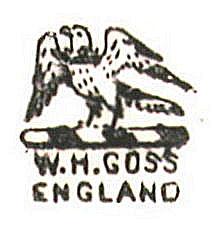
William Henry Goss (30 July 1833 London - 4 January 1906 Stoke upon Trent) was an English potter notable for having developed the souvenir trade in pottery with his Goss crested china.

William Henry Goss (30 July 1833 London - 4 January 1906 Stoke upon Trent) was an English potter notable for having developed the souvenir trade in pottery with his Goss crested china.
Born in London to Richard Goss and Sophia Mann, William was a student at the School of Design at Somerset House in London, from where in 1857 he was employed as chief artist of the Stoke upon Trent firm of William Taylor Copeland, who had bought the business interests of his partner Josiah Spode II. Shortly after, in 1858, Goss started his own business in Stoke upon Trent. At first he produced ivory porcelain of such quality as to merit an award at the 1851 International Exhibition. His experiments led to marked improvements in jewelled porcelain and heraldic china. [1] It was not until the 1880s, under the influence of his sons Adolphus, Godfrey, Victor and Huntley, were the famous small white-glazed vases and pots with heraldic arms for presentations being produced. These items made up a large portion of his production. These were soon joined by small items depicting interesting local scenery.
In 1906, a League of Goss Collectors was founded, becoming the International League in 1918
The business was taken over by Cauldon Potteries in 1929, the name Goss still being used. Finally it became a subsidiary of the Royal Doulton group. [2] By 1940, the Goss factory had ceased production.
In the late 1960s, Gossware became very collectable and in 1970 a modern Goss Collectors club was founded. Nearly all pieces of Gossware can be identified by a goshawk crest on the base with W. H. Goss printed underneath. Pieces made after 1931 also have the word England below the mark.
Besides his work in pottery, he wrote a few books, was the biographer of Llewellynn Jewitt, [3] was vice-president of the North Staffordshire Field Club, a fellow of the Royal Geographical Society and the Royal Meteorological Society.
His wife was Georgiana Goldswain whom he married in 1854 and they produced seven children, his son Adolphus later joining the business.
He was buried in Hartshill cemetery.

Josiah Spode was an English potter and the founder of the English Spode pottery works which became famous for the high quality of its wares. He is often credited with the establishment of blue underglaze transfer printing in Staffordshire in 1781–84, and with the definition and introduction in c. 1789–91 of the improved formula for bone china which thereafter remained the standard for all English wares of this kind.

Spode is an English brand of pottery and homewares produced in Stoke-on-Trent, England. Spode was founded by Josiah Spode (1733–1797) in 1770, and was responsible for perfecting two important techniques that were crucial to the worldwide success of the English pottery industry in the 19th century: transfer printing on earthenware, and the formula for fine bone china.

The Staffordshire Potteries is the industrial area encompassing the six towns Burslem, Fenton, Hanley, Longton, Stoke and Tunstall, which is now the city of Stoke-on-Trent in Staffordshire, England. North Staffordshire became a centre of ceramic production in the early 17th century, due to the local availability of clay, salt, lead and coal.

Creamware is a cream-coloured refined earthenware with a lead glaze over a pale body, known in France as faïence fine, in the Netherlands as Engels porselein, and in Italy as terraglia inglese. It was created about 1750 by the potters of Staffordshire, England, who refined the materials and techniques of salt-glazed earthenware towards a finer, thinner, whiter body with a brilliant glassy lead glaze, which proved so ideal for domestic ware that it supplanted white salt-glaze wares by about 1780. It was popular until the 1840s.

Armorial ware or heraldic china are ceramics decorated with a coat of arms, either that of a family, or an institution or place. Armorials have been popular on European pottery from the Middle Ages with examples seen on Spanish Hispano-Moresque ware, Italian maiolica, slipware, English and Dutch Delft, and on porcelain from the 18th century. Earlier examples were mostly large pieces such as jugs or basins and ewers, but later whole table services, all painted with the arms, were produced.

Goss crested china is typically in the form of small white glazed porcelain models, made from 1858 to 1939, carrying the coat of arms of the place where they were sold as a souvenir, thus being a form of model heraldic china.

The Royal Crown Derby Porcelain Company is the oldest or second oldest remaining English porcelain manufacturer, based in Derby, England. The company, particularly known for its high-quality bone china, having produced tableware and ornamental items since approximately 1750. It was known as 'Derby Porcelain' until 1773, when it became 'Crown Derby', the 'Royal' being added in 1890.
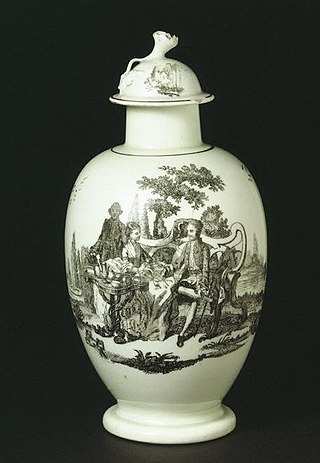
Royal Worcester is a porcelain brand based in Worcester, England. It was established in 1751 and is believed to be the oldest or second oldest remaining English porcelain brand still in existence today, although this is disputed by Royal Crown Derby, which claims 1750 as its year of establishment. Part of the Portmeirion Group since 2009, Royal Worcester remains in the luxury tableware and giftware market, although production in Worcester itself has ended.

Wedgwood is an English fine china, porcelain and luxury accessories manufacturer that was founded on 1 May 1759 by the potter and entrepreneur Josiah Wedgwood and was first incorporated in 1895 as Josiah Wedgwood and Sons Ltd. It was rapidly successful and was soon one of the largest manufacturers of Staffordshire pottery, "a firm that has done more to spread the knowledge and enhance the reputation of British ceramic art than any other manufacturer", exporting across Europe as far as Russia, and to the Americas. It was especially successful at producing fine earthenware and stoneware that were accepted as equivalent in quality to porcelain but were considerably cheaper.
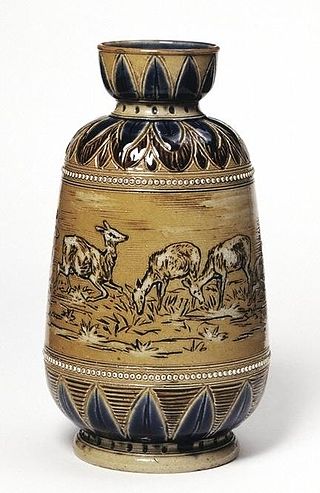
Royal Doulton is an English ceramic and home accessories manufacturer that was founded in 1815. Operating originally in Vauxhall, London, and later moving to Lambeth, in 1882 it opened a factory in Burslem, Stoke-on-Trent, in the centre of English pottery. From the start, the backbone of the business was a wide range of utilitarian wares, mostly stonewares, including storage jars, tankards and the like, and later extending to drain pipes, lavatories, water filters, electrical porcelain and other technical ceramics. From 1853 to 1901, its wares were marked Doulton & Co., then from 1901, when a royal warrant was given, Royal Doulton.

Thomas Minton (1765–1836) was an English potter. He founded Thomas Minton & Sons in Stoke-on-Trent, Staffordshire, which grew into a major ceramic manufacturing company with an international reputation.

Mintons was a major company in Staffordshire pottery, "Europe's leading ceramic factory during the Victorian era", an independent business from 1793 to 1968. It was a leader in ceramic design, working in a number of different ceramic bodies, decorative techniques, and "a glorious pot-pourri of styles - Rococo shapes with Oriental motifs, Classical shapes with Medieval designs and Art Nouveau borders were among the many wonderful concoctions". As well as pottery vessels and sculptures, the firm was a leading manufacturer of tiles and other architectural ceramics, producing work for both the Houses of Parliament and United States Capitol.
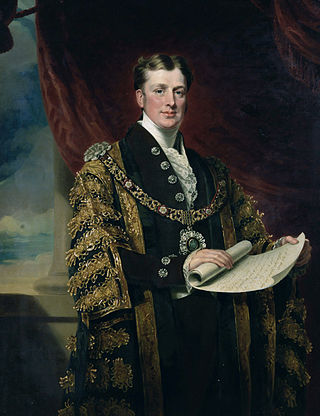
William Taylor Copeland, MP, Alderman was a British businessman and politician who served as Lord Mayor of London and a Member of Parliament.

Carlton Ware was a pottery manufacturer based in Stoke-on-Trent. The company is known for its tableware, often in the form of highly decorated leaves or fruit, and the ceramic toucans it made as promotional items for Guinness. It produced hand-painted domestic pottery in high art deco styles during the 1920s and 1930s.
John Beswick Ltd, formerly J. W. Beswick, was a pottery manufacturer, founded in 1894 by James Wright Beswick and his sons John and Gilbert in Longton, Stoke-on-Trent. In 1969, the business was sold to Doulton & Co. Ltd. The factory closed in 2002 and the brand John Beswick was sold in 2004. The pottery was chiefly known for producing high-quality porcelain figurines such as farm animals and Beatrix Potter characters and have become highly sought in the collectables market. Pronunciation of Beswick is as at reads, Bes-wick. This information was from employees who worked at the original Beswick factory.
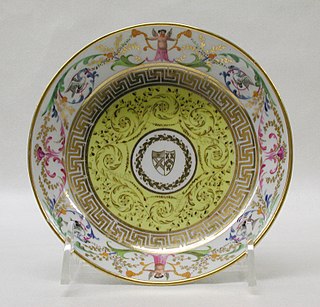
Thomas Baxter Jnr. was an English porcelain painter, and a watercolour painter and illustrator.

The Ridgway family was one of the important dynasties manufacturing Staffordshire pottery, with a large number of family members and business names, over a period from the 1790s to the late 20th century. In their heyday in the mid-19th century there were several different potteries run by different branches of the family. Most of their wares were earthenware, but often of very high quality, but stoneware and bone china were also made. Many earlier pieces were unmarked and identifying them is difficult or impossible. Typically for Staffordshire, the various businesses, initially set up as partnerships, changed their official names rather frequently, and often used different trading names, so there are a variety of names that can be found.
H & R Daniel is a little known manufactory of porcelain and earthenware. During the 24 years the pottery was in operation it was considered of equal stature with Spode, Minton and their contemporaries. The pottery was situated in Stoke on Trent, Staffordshire, England.

Leeds Pottery, also known as Hartley Greens & Co., is a pottery manufacturer founded around 1756 in Hunslet, just south of Leeds, England. It is best known for its creamware, which is often called Leedsware; it was the "most important rival" in this highly popular ware of Wedgwood, who had invented the improved version used from the 1760s on. Many pieces include openwork, made either by piercing solid parts, or "basketwork", weaving thin strips of clay together. Several other types of ware were produced, mostly earthenware but with some stoneware.

The original Castleford Pottery operated from c. 1793 to 1820 in Castleford in Yorkshire, England. It was owned by David Dunderdale, and is especially known for making "a smear-glazed, finely moulded, white stoneware". This included feldspar, giving it a degree of opacity unusual in a stoneware. The designs typically included relief elements, and edges of the main shape and the panels into which the body was divided were often highlighted with blue overglaze enamel. Most pieces were teapots or accompanying milk jugs, sugar bowls and slop bowls, and the shapes often derived from those used in contemporary silversmithing.